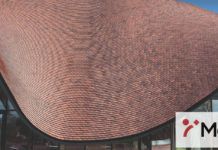 Thin leading edge interlocking concrete tiles, made to replicate the look of natural slate on a budget, are not a new invention. In fact, one of the first products launched into the market was our own Edgemere slate, over a decade ago. Whilst sales have grown steadily since it was launched, we have seen sudden unprecedented growth since the recovery in the house-building market, particularly in the last year.
Thin leading edge interlocking concrete tiles, made to replicate the look of natural slate on a budget, are not a new invention. In fact, one of the first products launched into the market was our own Edgemere slate, over a decade ago. Whilst sales have grown steadily since it was launched, we have seen sudden unprecedented growth since the recovery in the house-building market, particularly in the last year.
With the wider financial recovery and schemes such as Help to Buy giving a significant boost to house-building, it is really no surprise that sales of all roofing products have grown significantly in the past couple of years. However, we have noticed that sales of our thin leading edge concrete slates are disproportionately high. Since the start of 2012, demand has more than doubled and we have seen a 46% increase in the last year alone. The biggest increase has been in private housing development but it still remains popular for both social housing new build and refurbishment.
So, what is driving this sudden demand for a product that has been around for ten years? Without a doubt, getting a premium aesthetic for a small budget is the driving force behind the surge in demand for thin leading edge concrete slates. They also offer a middle ground between the top and bottom of the pricing range – not only are they a cost effective alternative to natural slate, but they are also an affordable upgrade to standard concrete interlocking tiles.
Elevate the exterior aesthetic
One particular trend we have noticed is the use of our Edgemere slates on new private housing developments seeking to differentiate themselves with a contemporary exterior and high internal specification. Using a concrete interlocking slate over a standard tile gives house-builders the chance to elevate the exterior aesthetic, giving a premium slate look without much additional cost. This enables them to maximise the external look on a budget and spend more on the internal specifications, which are often the key deciding factor in the sale of a house.
Many house-builders and roofing contractors have realised there is a relatively small uplift in cost between using a standard flat concrete interlocking tile and a premium look concrete slate. In fact, the difference can be as little as 3% extra on the total cost of a standard domestic roof, yet it provides greatly enhanced aesthetics. The average cost of a re-roof is around œ3,500, so you are only talking about just over œ100 to upgrade from a standard to a premium-look aesthetic.
Shift to thin leading edge
When we introduced the Edgemere range to the market a decade ago, it was probably slightly ahead of its time. We predicted that at some point, thin leading edge slates would become the standard specification over traditional interlocking concrete tiles and we still believe this will be the case. However, due to the impact of the recession and slowdown in the house-building sector, we are only now seeing the true effects of this market change. We can now clearly see a shift in specifications towards using a thin leading edge concrete slate as standard, and these now account for a growing proportion of our flat concrete sales.
There has clearly been an aesthetic shift in private housing, where builders are looking for a sleeker slate look. Fifteen years ago it would have been fairly common practice for a development of four bedroom houses to all be roofed in traditional interlocking concrete tiles. These days you would expect a development like this to have thin




